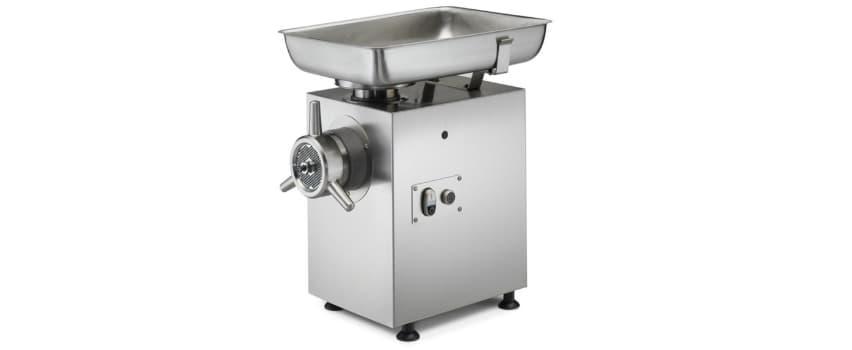How to choose the best meat mincer for your business
Whether you’re a high street butcher, or work at a commercial meat processing facility, the right meat mincer can make all the difference to efficiency, cost-effectiveness, and ultimately the quality of your product. All key reasons why it’s so important to choose them carefully!
The thing is, of course, that there’s a huge range of options to choose from, especially amongst our own range here at Butchers Equipment Warehouse. So, if you need a bit of help getting started, you’re in exactly the right place. Here’s a quick roundup of some of the key factors you need to know!
A quick summary of the different types of meat mincers
Before we get started on anything else, it’s worth us taking a moment to quickly recap
the different types of meat mincers available. Meat mincers generally fall into three categories: manual, electric, and commercial.
Manual mincers are operated by hand and are best suited for smaller volumes of meat. They are often more affordable and require less maintenance, but can be labour-intensive. These mincers are ideal for small butcher shops or restaurants that only need to process small amounts of meat occasionally. However, the manual effort required means that they’re not always a practical option for businesses looking to scale up their production.
Electric mincers offer a more efficient solution for medium to high volumes. They come in various sizes and power levels, providing a good balance between speed and ease of use. Electric mincers are highly versatile, allowing you to process different types of meat quickly and with less physical effort. This makes them a popular choice for medium-sized businesses that need to maintain a steady output while ensuring consistent quality.
Commercial mincers are designed for high-volume operations and are built to withstand rigorous use. They typically feature higher power motors and larger capacities, making them ideal for busy butcheries or food processing businesses. These machines are built to handle continuous operation, ensuring that large batches of meat can be processed efficiently. While they represent a larger investment, their durability and efficiency can lead to significant cost savings in the long run – so as you’d expect, they’re particularly popular for large-scale commercial businesses.
The Omega Meat Mincer TA-32X is a perennially popular one amongst our customers here at Butchers Equipment Warehouse, so if you’re not sure exactly what type of mincer, it’s always a reliable all-rounder!
Assess size and capacity requirements
Once you’ve settled on the type of mincer you need, the next step is to determine the right size and capacity of the meat mincer you need. The size of the mincer should fit comfortably in your workspace, allowing easy access for staff and ensuring that there’s sufficient room for operation and cleaning. Additionally, it’s a good idea to take any future growth into account when looking at the size – for example, choosing a mincer that’s too small might meet current needs but could become a bottleneck for you further down the line.
Capacity is equally important – choosing a mincer with the appropriate capacity is crucial for meeting your daily meat processing requirements. Smaller models might be adequate for occasional use, but if you’ve got a business with high throughput, you’ll probably benefit more from larger, industrial models that can handle significant volumes efficiently. A mismatch between capacity and actual processing needs can lead to inefficiencies, so it’s wise to plan based on peak usage rather than average requirements.
Evaluate power and performance
Power and performance are critical factors that influence the effectiveness of a meat mincer. The power of a mincer, typically measured in wattage for electric models and horsepower for commercial ones, directly affects how efficiently the machine can process meat, especially tougher cuts. A more powerful motor generally means faster grinding and the ability to handle larger quantities with ease.
Performance features, such as multiple grinding speeds and the capability to process different textures of meat, can significantly impact the quality and consistency of the final product.
Additionally, the ability to switch between coarse and fine grinds quickly can enhance versatility, allowing you to produce a wider range of products without needing multiple machines.
Again, there’s a strategic decision to be made here. It’s obviously important to match the power level to your actual needs, as overpowered models might consume more energy than necessary, leading to higher operational costs. On the other hand, if you’re looking at growing your business, a more powerful meat mincer can be a handy long-term investment, as the improved efficiency and product quality can lead to greater profitability over time.
Consider material and build quality
The material and build quality of a meat mincer have a direct impact on its durability, hygiene, and ease of maintenance. Stainless steel is the preferred material for meat mincers, known for its resistance to rust and ease of cleaning. This material ensures that the mincer can endure heavy-duty use without deteriorating over time. Stainless steel also minimises the risk of contamination, which is crucial in maintaining food safety standards.
The build quality also needs to be robust, with stable construction to withstand regular operation. This includes ensuring that parts like the blade and auger are made from high-quality materials that won’t wear out quickly. A well-built mincer not only lasts longer but also provides better safety and reliability during use, making it a worthwhile investment for any business. Poor build quality can lead to frequent breakdowns and costly repairs, which can disrupt your operations and increase downtime.
Check ease of cleaning and maintenance
Obviously, hygiene is one of the top priorities in any food preparation environment, and the ease of cleaning a meat mincer plays a significant role in this. For that reason alone, it’s always a good idea to choose a mincer with removable parts that are either dishwasher safe or easy to clean manually, as this will help streamline the cleaning process and ensure high standards of cleanliness. The ability to disassemble the mincer quickly can save valuable time, especially in busy environments where machines need to be cleaned frequently.
Regular maintenance is also necessary to keep the mincer operating at its best. Models that offer easy access to parts for lubrication and inspection will save time and effort in the long run, helping you maintain the equipment’s longevity and performance. Keeping a detailed maintenance schedule can prevent minor issues from escalating into major problems, ensuring that your mincer remains reliable and efficient over time. Investing in a model with a good warranty and readily available spare parts can further simplify maintenance, reducing the risk of prolonged downtime.
And if you’re looking for the very best meat mincers for your business, you’re in exactly the right place. Here at Butchers Equipment Warehouse, we supply a great range of meat mincers and butchers machinery, and all for the very best prices. And of course, if you’ve ever got any questions or need any advice about our products, just give our team a call on 01254 427 761. We’re always happy to help!




